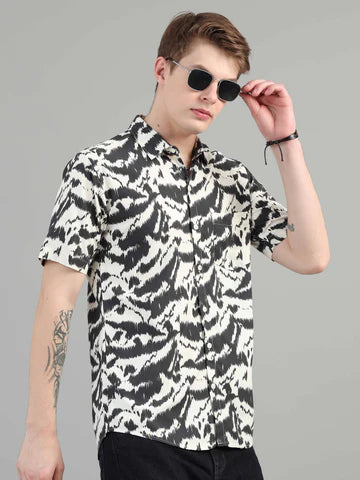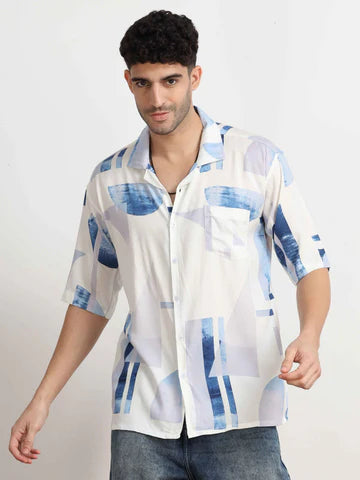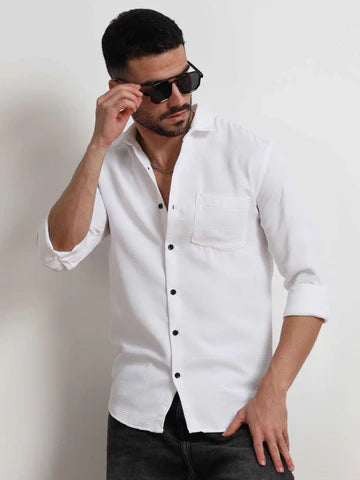
Soft, Stiff, or Stretchy? Decoding the Comfort Levels of Men's Shirt Fabrics
Share
When it comes to choosing the right men's shirt, comfort is just as important as style. A shirt's fabric determines how it feels against the skin, how it moves with your body, and how it holds up throughout the day. But with so many options available, how do you decide between soft, stiff, or stretchy fabrics?
This guide will help you understand the key factors that influence comfort in mens shirts fabric and how different fabric textures impact wearability.
Table of Contents
- Understanding Fabric Comfort
- What Makes a Shirt Soft?
- Why Do Some Shirts Feel Stiff?
- How Does Stretch Affect Shirt Comfort?
- Choosing the Right Comfort Level for Different Occasions
- FAQs About Men's Shirt Comfort Levels
Understanding Fabric Comfort
The feel of a shirt isn't just about the fabric itself—it’s influenced by multiple factors such as weave, thickness, and flexibility. A shirt that feels comfortable in one situation may not be ideal in another.
The three main comfort levels of shirts are:
- Soft Shirts – These provide a smooth and cozy feel, making them ideal for casual and all-day wear.
- Stiff Shirts – Known for their structured look, these offer a crisp appearance but can feel restrictive.
- Stretchy Shirts – Designed for movement, these offer flexibility and adaptability to body shape.
Each comfort level has its own advantages, and choosing the right one depends on personal preference and the occasion.
What Makes a Shirt Soft?
A soft shirt is all about comfort and breathability. When a shirt is soft, it drapes naturally over the body, reducing irritation and allowing airflow.
Key Features of Soft Shirts
- Lightweight Feel – These shirts are often airy and don’t weigh you down.
- Skin-Friendly Touch – The surface feels smooth against the skin, making it less likely to cause irritation.
- Breathable Structure – Allows airflow, preventing overheating.
Shop Now : Grey & Blue Stripe Shirt
Benefits of Soft Shirts
- Ideal for casual wear and relaxed settings.
- Provides all-day comfort for long hours of wear.
- Reduces chafing and irritation, especially for those with sensitive skin.
However, soft shirts may not always maintain a sharp structure, and they can wrinkle more easily compared to stiff fabrics.
Why Do Some Shirts Feel Stiff?
Stiff shirts offer a more formal and polished appearance. These shirts often hold their shape well and are preferred in professional settings.
Key Features of Stiff Shirts
- Crisp Appearance – Keeps a well-defined look without sagging.
- Structured Fit – Offers a tailored shape, enhancing the silhouette.
- Durable and Long-Lasting – Maintains its form even after multiple wears.
Shop Now : Light Khaki Doodle Printed Shirt
Benefits of Stiff Shirts
- Perfect for formal occasions like business meetings and weddings.
- Ensures a sharp and clean look throughout the day.
- Less prone to wrinkling, keeping the outfit neat.
While stiff shirts enhance style, they may feel restrictive, especially when worn for long hours. They also require precise sizing for comfort.
How Does Stretch Affect Shirt Comfort?
Stretchy shirts are designed for ease of movement and flexibility. They combine comfort with adaptability, making them a great choice for active individuals.
Key Features of Stretchy Shirts
- Flexible Fit – Moves with the body, making it ideal for various activities.
- Enhanced Mobility – Perfect for those who need a balance of style and performance.
- Shape Retention – Maintains its fit without becoming baggy.
Shop Now : Brown Abstract Printed Oversized Shirt
Benefits of Stretchy Shirts
- Suitable for dynamic environments, such as work settings requiring movement.
- Provides a comfortable fit without feeling too tight.
- Resists deformation, ensuring long-term durability.
Stretchy shirts are a great choice for those who need a blend of comfort and style, but they may not offer the same structured look as stiff shirts.
Choosing the Right Comfort Level for Different Occasions
Selecting the best comfort level depends on the occasion, weather, and personal preference.
|
Occasion |
Recommended Comfort Level |
|
Office/Formal Meetings |
Stiff or Soft Shirts |
|
Casual Outings |
Soft or Stretchy Shirts |
|
Traveling |
Soft or Stretchy Shirts |
|
Active Work Environment |
Stretchy Shirts |
|
Special Events |
Stiff Shirts |
If comfort is your priority, soft and stretchy shirts are excellent choices. However, if you need a professional look, a stiff shirt will give you the polished appearance you need.
FAQs About Men's Shirt Comfort Levels
1. How do I know if a shirt will be comfortable?
Comfort depends on the fabric texture, thickness, and flexibility. Look for breathable and soft materials if you want everyday comfort, while structured fabrics provide a crisp look.
2. Are stretchy shirts better than soft or stiff shirts?
Stretchy shirts offer great flexibility, making them ideal for movement. However, soft shirts provide all-day comfort, and stiff shirts offer a formal, polished look. The best choice depends on your needs.
3. Do stiff shirts become softer over time?
Yes, some stiff shirts may soften after multiple washes. However, they will still retain their structured look. If you prefer a softer feel, consider pre-washed options.
4. Can a shirt be both soft and stretchy?
Yes! Some fabrics combine softness and stretch for added comfort and flexibility. These shirts provide the best of both worlds, ensuring ease of movement while feeling gentle on the skin.
5. Which type of shirt is best for summer?
Soft and breathable shirts are ideal for summer as they allow airflow and prevent overheating. Stretchy shirts can also work well if they provide good ventilation.
Final Thoughts
Understanding the comfort levels of casual shirt fabric helps you make informed choices based on style, function, and occasion. Whether you prefer soft for relaxation, stiff for formality, or stretchy for movement, each comfort level serves a unique purpose.




